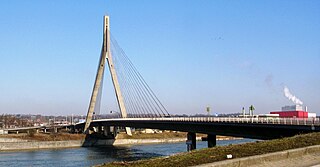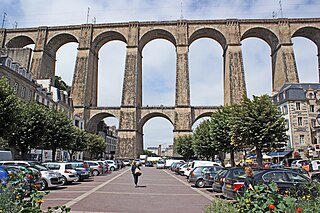This list of bridges in Belgium lists bridges of particular historical, scenic, architectural or engineering interest in Belgium. Road and railway bridges, viaducts, aqueducts and footbridges are included.

The Millau Viaduct is a multispan cable-stayed bridge completed in 2004 across the gorge valley of the Tarn near Millau in the Aveyron department in the Occitanie Region, in Southern France. The design team was led by engineer Michel Virlogeux and English architect Norman Foster. As of October 2023, it is the tallest bridge in the world, having a structural height of 343 metres (1,125 ft).

The Pont de Bir-Hakeim, formerly the Pont de Passy, is an arch bridge that crosses the Seine in Paris. It connects the 15th and 16th arrondissement, passing through the Île aux Cygnes. The bridge, made of steel, was constructed between 1903 and 1905, in replacement of a footbridge that had been erected in 1878. The bridge has two levels: one for motor vehicles and pedestrians, the other being a viaduct built above the first one, through which passes Line 6 of the Paris Métro. The bridge is 237 metres (777 ft) long and 24.7 metres (81 ft) wide. The part crossing the Grand Bras of the Seine is slightly longer than the one crossing the Petit Bras.

The Chemin de fer des Côtes-du-Nord, the Côtes-d'Armor today, was a 1,000 mm, metre gauge, railway in Côtes-du-Nord, France, although there were a few kilometres of line in Finistère and Ille-et-Vilaine. The first lines opened in 1905 and final closure was in 1956. The lines were a voie ferrée d'intérêt local system with a total extent of 457 kilometres (284 mi).

The Pont de Wandre is a single-pier cable-stayed bridge carrying the N667 road across the Albert Canal and the river Meuse between Liège and Herstal, both in Belgium.

Jozef "Jef" Schils was a Belgian cyclist.

Paul Séjourné was a French engineer who specialized in the construction of large bridges from masonry, a domain in which he made some important innovations.

The Morlaix viaduct is a railway bridge, of the viaduct type, located in the city of Morlaix which allows the crossing of the Morlaix river and the service to the city station by the line from Paris-Montparnasse to Brest.